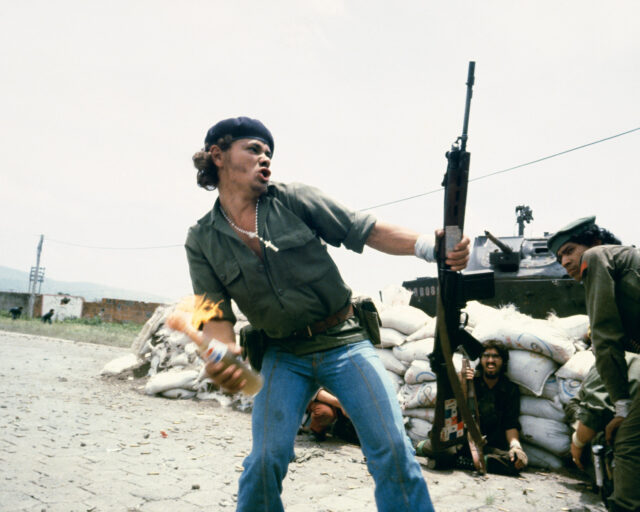Gordon Parks, a Brazilian Child, and an Exposé that Shocked the World
A 1961 photo-essay about the struggles of Flávio, a twelve-year-old Brazilian favela dweller, elicited unprecedented response. But should an American publication have tried to “rescue” a boy from poverty?

“The Compassion of Americans Brings a New Life for Flavio,” Life, July 21, 1961. Cover photograph by Carl Iwaski
Courtesy The Gordon Parks Foundation
The artistic career of Gordon Parks (1912–2006), which spans nearly seven decades and a variety of mediums, is so rich and diverse that it refuses simplification. Even singular projects resist linear interpretation. Case in point: the Flávio story. On assignment for Life magazine in the early sixties, Parks traveled to Rio de Janeiro with the mandate to produce a visual exposé on poverty that would elicit empathy. Eschewing instructions from the magazine’s editorial leadership to follow an impoverished father, he chose to focus on an adolescent suffering from bronchial asthma and malnutrition, Flávio da Silva, who lived in dire conditions in Catacumba, a hillside favela near an affluent enclave of the city. Nearly sixty years later, a new book and exhibition, Gordon Parks: The Flavio Story, reconsider the legacy of this famous encounter.
“Breathing hard, balancing a tin of water on his head, a small boy climbed toward us. He was miserably thin, naked but for filthy denim shorts. His legs resembled sticks covered with skin and screwed into his feet. Death was all over him, his sunken eyes, cheeks and jaundiced coloring. He stopped for breath, coughing, his chest heaving as water slopped over his bony shoulders. Then jerking sideways like a mechanical toy, he smiled a smile that I will never forget. Turning, he went on up the mountainside,” Parks wrote in his autobiography Voices in the Mirror (1990). “This frail boy bent under his load said more to me about poverty than a dozen poor fathers.”
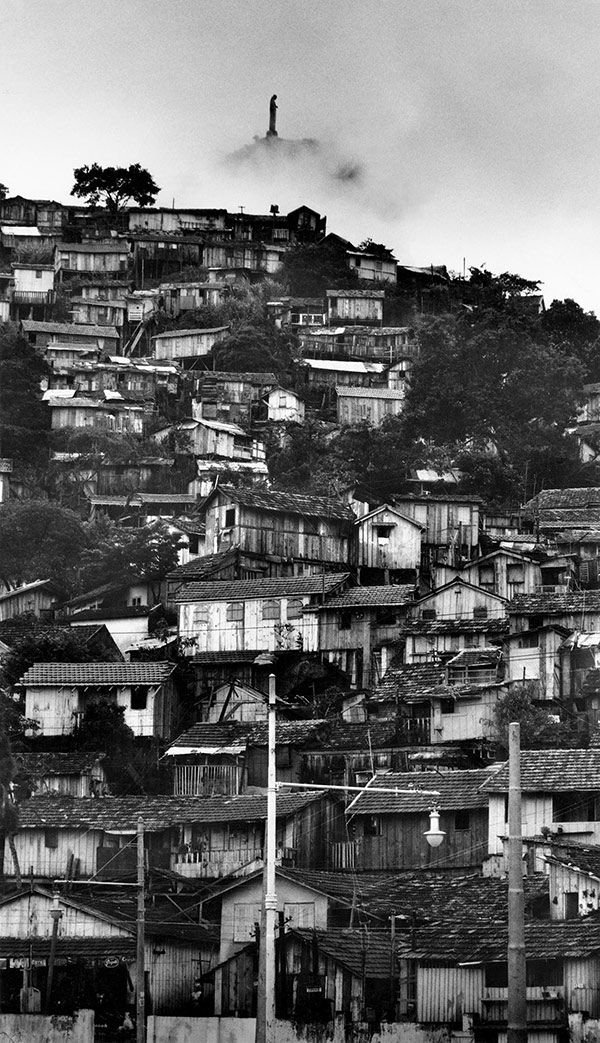
Gordon Parks, Untitled, Rio de Janeiro, Brazil, 1961
Courtesy The Gordon Parks Foundation
For the next eighteen days, according to the diary published alongside the feature, from March 22 to April 9, 1961, Parks would climb that very mountainside to photograph the young boy and his family. Bleak images show Flávio struggling to breathe in bed, caring for his siblings, and getting through his daily chores. He appears, in many ways, to be the man of the house, responsible for the family’s survival despite his own illness. It’s a portrait of resignation. There are no smiles being exchanged, no hints of love, joy, or even playfulness, aside from a small image of Flávio and his brother kicking sand on the Copacabana Beach, where Parks took them after learning they had never been, despite living only ten minutes away from it.
Published under the headline “Freedom’s Fearful Foe: Poverty,” the photos pulled at Life readers’ heartstrings. They sent letters of sympathy, offering money and help. The Children’s Asthma Research Institute in Denver wrote to promise pro bono care for the ailing teenager. Parents imagined how they would feel if this were their child. Life couldn’t have hoped for a better response. Thirty thousand dollars (the equivalent of roughly $250,000 today) were collected. The family was resettled in a nicer neighborhood. Flávio was flown to the United States to receive treatment at the aforementioned hospital. Life made sure to document these efforts in a report printed five weeks later, entitled “The Compassion of Americans Brings a New Life for Flávio.”
Gordon Parks: The Flávio Story dissects this feel-good narrative. Curators Paul Roth, from the Ryerson Image Centre in Toronto, and Amanda Maddox, from the Getty Museum in Los Angeles, in partnership with the Gordon Parks Foundation in New York and Instituto Moreira Salles in Rio de Janeiro, interrogate the context in which the feature was created, look at reactions it spurred in Brazil, and explore the lasting consequences of what was at the time referred to as a “rescue.” Earlier this fall, I spoke to Roth about the alleged power of photography, the influence and responsibilities of publication owners, editors, photographers, and readers, and the necessity to reject easy, black-and-white interpretations of iconic works.
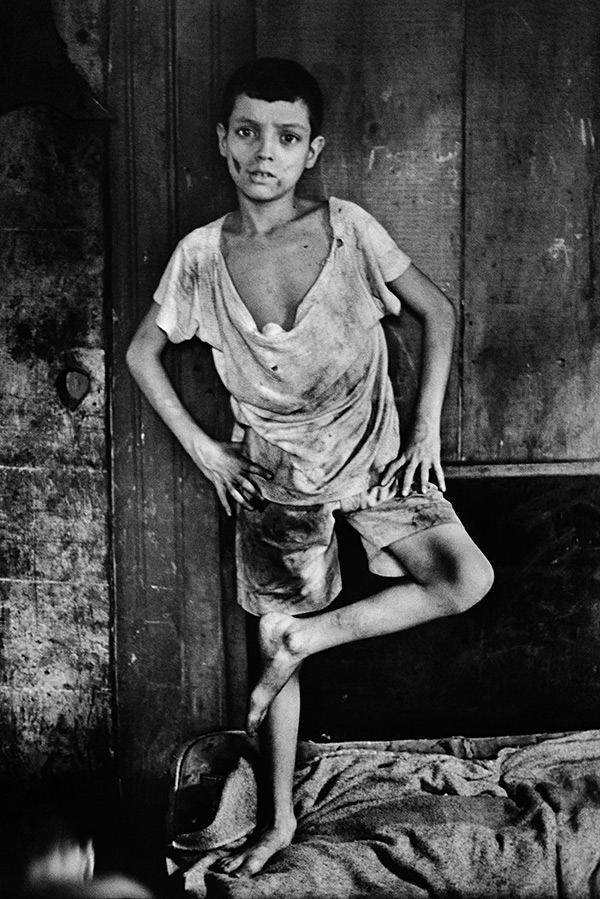
Gordon Parks, Flavio da Silva, Rio de Janeiro, Brazil, 1961
Courtesy The Gordon Parks Foundation
Laurence Butet-Roch: The Ryerson Image Centre, as a photo institution set within a university, has the responsibility to provide exhibitions that examine the medium and its practices. Last year, you featured the project Collaboration by Ariella Azoulay, Wendy Ewald, Susan Meiselas, Leigh Raiford, and Laura Wexler, which offers an alternative history of photography grounded in a range of collaborative processes. Before that, you hosted an exhibition of historical images of Canada from the New York Times archive in a bid to discuss the representation of the country in news media. And before that, you programmed Attica USA 1971: Images and Sounds of a Rebellion, curated by Philippe Artieres for Le Point du Jour, which recontextualized the coverage of the Attica prison riots, to name a few recent memorable exhibitions at the RIC. How does Gordon Parks: The Flávio Story fit within that mandate?
Paul Roth: Before I even came to the Ryerson Image Centre, I had the idea of organizing an exhibition about this reportage, which was once Gordon Parks’s best-known photo-essay. But, the truth is, I’m not sure we could have curated it this way at any other institution. It fits so perfectly with our mandate of trying to interrogate what photography is, how it communicates, and how people understand it. To unpack The Flávio Story, to place it in historical context and reveal its social impact, we’re showing Parks’s photographs alongside images by many other makers, professional and amateur, and with documentary materials that many institutions would be reluctant to exhibit. This includes lots of publications, corporate and institutional records and correspondence, Parks’s original working materials, and images that have never been printed, that we found in the course of our research.
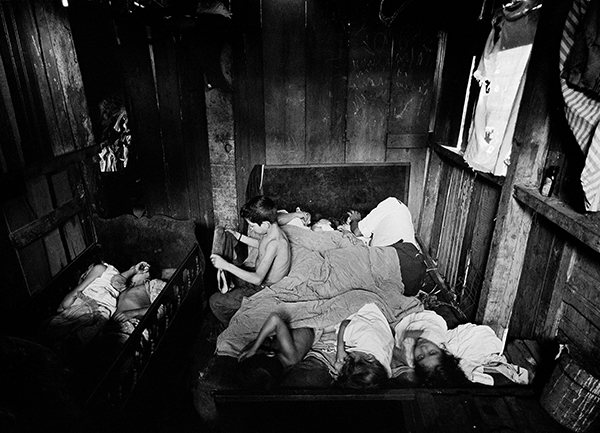
Gordon Parks, Family’s Day Begins, Rio de Janeiro, Brazil, 1961
Courtesy The Gordon Parks Foundation
More importantly, we discuss The Flávio Story not just as a classic picture story with extraordinary images, but also as the product of Parks’s midcareer ambitions, as an ambitious corporate media project, for its stunning appeal to Life’s middle-class audience, and for the controversy of its publication in Brazil. Now, obviously, many museums and curators have become more flexible and open in their examination of historically important artistic projects, in making their checklists and in exhibition display, in order to better contextualize the stories they tell. But for many others, especially older institutions, it can be hard to make these shifts.
Our partners at the Getty Museum are trying, as we speak, to figure out how to handle a lot of the display choices that we’ve been able to make more easily at the RIC, because we aren’t bound by the same traditions and ideas about audience, and thus we can think quite differently. Ultimately, it seems to me that our goal in this time and place is to find new ways of telling the stories of photography, so that we not only retell the stories that the artist or photographer told, but that we also question how the stories were told, and how they have been understood. Because of this, we’re actually asking our audience to come to a Gordon Parks show where a majority of the pictures are not by him!

Gordon Parks, Flavio After Asthma Attack, Rio de Janeiro, Brazil, 1961
Courtesy The Gordon Parks Foundation
Butet-Roch: Many uphold The Flávio Story as one of the few examples of photography’s purported power to effect positive change. Here, you challenge that conclusion.
Roth: It’s really up for debate. Looking at Parks’s story and the effort to save Flávio only as a cautionary tale would also be too easy. Some of my colleagues here in Canada have analogized it to the residential schools program, whereby indigenous children were ripped away from their parents and dropped off in abusive spaces to have their culture removed. To this day, Flávio doesn’t see his experience that way. He shared his point of view with us over several interviews. Instead, he’s angry that he was taken away from the place he was brought to!
The initial situation he was taken from was so perilous. He was twelve years old, on the verge of dying due to asthma, had a terrible relationship with his parents, was physically abused, and lived in a swirl of psychic violence that we can hardly imagine. So for him, being on the cover of a big American magazine, getting toys and clothes, being deposited with a family that he liked better than his own, felt like winning the lottery. He was so incredibly distraught when he eventually had to leave his new life in Denver. He acknowledges that something wrong happened to him, but to him it isn’t that Gordon Parks and Life interfered in his life, but that he wasn’t permanently adopted by any of the people involved, like Gordon Parks, Ruth Fowler, the executive assistant to Life’s publisher, José Gallo, the longtime business manager at the Rio de Janeiro bureau of Time Inc. assigned to assist Parks as reporter and interpreter on the Flávio story, or the family he lived with in Denver. He asked all of them to adopt him. They all said no. They all felt that they were doing the right thing by returning him to his own family in the country of his birth. But Flávio didn’t want to go home to his family. Photos taken by José Gonçalves, his surrogate father in the United States, bear witness to these emotions.
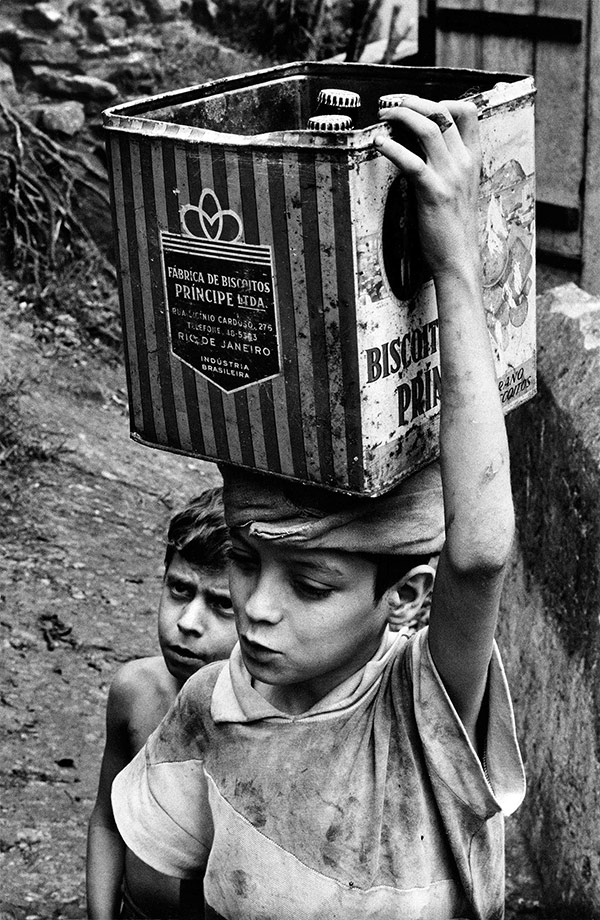
Gordon Parks, Untitled, Rio de Janeiro, Brazil, 1961
Courtesy The Gordon Parks Foundation
Having said that, Flávio was fourteen years old at that point, and one could argue that he had no way of understanding the complexity of his situation. All the people involved were already terribly worried that they were going to cause him harm. They obsessed over that, the magazine’s employees included. Yet at the same time, they didn’t really understand, they couldn’t. And, it’s important to remember that they weren’t doing all this for purely innocent or altruistic reasons; they had very complicated motives. All this to say that an uncomplicated absolutist read of this story, positive or negative, is not only misguided, but also not really that illuminating or interesting. Like all claims made about the power of photography, it’s much more revealing to look at the fragility of those declarations than to take them at face value. That’s why I love this story so much: there are so many moments and details you can interrogate.

Jose Gallo, Gordon Parks carrying Zacarias, Rio de Janeiro, Brazil, 1961
Courtesy The Gordon Parks Foundation
Butet-Roch: The first part of your investigation rests in scrutinizing the context in which this photo-essay was commissioned by Life. It was part of a series entitled “Crisis in Latin America,” which was launched with an introduction that began: “The messianic eyes of Fidel Castro, hypnotic and hungry for power, summon up a new and nightmarish danger for the U.S.” This came six weeks after the failed CIA-supported Bay of Pigs invasion and as the Kennedy administration was pitching the “Alliance for Progress” economic interventionist policy for Latin America. Knowing the strong relationship between Life’s owner, Henry Luce, and the American leadership, should it be apprehended as propagandist?
Roth: Certainly, but it’s complicated. Henry Luce was many things, including an absolute anti-communist crusader. At the same time, he was also a self-proclaimed humanist. In other words, his corporatism and paranoid defensive foreign policy coexisted with his human-uplift politics. He embodied the idea of American exceptionalism. He built many magazines to carry this message forward—principally Time, Life, and Fortune—which became citadels for the people he employed, many of whom were political liberals, thereby empowering them. So, in a sense he created a paradoxical situation: On the one hand, he stated very clearly to his editors and reporters that he needed them to be propagandists in this war—these are words he actually used—believing that their role was as important as any army’s. However, and this is no surprise, many of Time-Life’s staff and contributors resisted Luce’s politics for a variety of different reasons.

Paulo Muniz, Untitled, Rio de Janeiro, Brazil, 1961
Courtesy The Gordon Parks Foundation
Butet-Roch: Where does Gordon Parks fit within that milieu?
Roth: Gordon Parks didn’t directly oppose these ideals per se; rather, he was opposed to the tedium of politics and what that would mean for his pictures. He had enough power by this point in his career, in 1961 when he was assigned to make pictures for this Latin America story, to fight back a little. He felt that it would be dull for Life’s readers to see a programmatic set of pictures that exemplified the editors’ political convictions. So, while he fulfilled some of their demands, which came in the form of an assignment list of desired images, Parks more or less ignored the editors. Rather than build his picture story around the father, as he had been assigned, Parks chose to focus on Flávio.
You can feel this uneasy marriage between the assignment and the images Parks actually brought back in the text that accompanies the photographs in Life magazine. The first block of text is very much what the editors wanted to get across about communism. The lead writer, Timothy Foote, presented poverty as a compelling pretext for the United States to solve, in order to prevent Latin American countries from being swallowed whole by communism. The cover headline, “Shocking Poverty Spawns Reds,” is telling. Yet, at the end of the photo-essay, an additional text is provided by Parks himself, a direct yet emotional diary of his experiences.The politics have been drained out of the pages and replaced by a language that buttresses the emotional impact of the pictures.
This is why this story is so complicated. Yes, Henry Luce was trying to support Kennedy; and many Time-Life staff members certainly voted for him and wanted him to succeed, believing that the Alliance for Progress would be a force for good in South and Central America. But they also had a more human reaction to this story of a single child suffering in poverty. When Life’s readers responded in kind, the staffers got excited because they could now help a single family, as a kind of proxy for all the people of Latin America.

José Gonçalves, Untitled, Denver, Colorado, 1963
Courtesy The Gordon Parks Foundation
Butet-Roch: The ideals you speak of, the context in which this work was created and seen, and the readers’ response evoke the white-savior complex, especially given how the humanist instincts of the magazine and its readership were then celebrated, just five weeks after the original picture story was published, in a self-congratulatory follow-up story: “The Compassion of Americans Brings a New Life for Flávio.”
Roth: I think that’s certainly true. The reaction expresses several things at once. For one thing, the magazine was just bluntly kissing up to their readers. At that time, Life’s publishers were increasingly concerned about their subscription and newsstand sales. In fact, circulation numbers were at their highest in the magazine’s history, just over seven million per week. With each copy passed between families and neighbors, it’s been estimated that anywhere from thirty-five million to one hundred million people saw every issue. But the publishers were still very worried, because it’s 1961 and television is increasing its market share and taking more advertising dollars from the magazines. There’s also a more crowded competitive space among weekly publications. So that’s why the cover featured Flávio smiling, in a clean bed, with a stuffed dog. The message was: you, the readers of Life magazine, contributed to saving this boy’s life.
Another reason Life was drawn to this intervention is that it helped them to visualize a journey from poverty and suffering to middle-class life, which was kind of an obsession with the magazine—because of who their readers were. The layout of the “rescue” issue is actually organized to reflect that ascent: Flávio and his family climb down the hillside of their favela, enter their new home, they get new furniture and clothes. Flávio flies to the United States, he’s diagnosed and treated by the best doctors, he learns how to play with other children, he learns how to speak English, then he starts making new friends.
So this story of redemption from poverty served many purposes for Life. The magazine could demonstrate its own power and reach, while also suggesting to its readers that by reading Life, they could contribute to the betterment of the world. Furthermore, the intervention suggested that John F. Kennedy’s policy—a continental foreign-aid program designed to save families like Flávio’s—could be successful.

José Gonçalves, Untitled, Denver, Colorado, ca. 1963
Courtesy The Gordon Parks Foundation
Butet-Roch: Still, this story encountered some criticism, initially and almost immediately, from the Brazilian government and media.
Roth: When North American media outlets do a story on poverty or war on the other side of the world, we, the North American readers, typically only care about our own reaction to that story. Very few people would even wonder whether there’s a response in the media of that place. In 1961, the press in Brazil immediately condemned the Flávio piece. They knew what Life and the story represented: a stalking horse intended to promote a financial aid policy that wasn’t fully supported within Brazil. There were opinion columns, news articles, even editorial cartoons.
One publication, O Cruzeiro, launched a two-pronged attempt to attack and debunk the story. First, they critiqued Parks’s photo-essay by flipping Life’s idea on its head, by sending their photographer Henri Ballot to depict poverty in the U.S., in New York, where Time-Life kept its corporate headquarters. O Cruzeiro’s counterattack was deliberate and overt. When they published Ballot’s photographs of a Puerto Rican family living in poverty on the Lower East Side, their page spreads were designed to echo corresponding page spreads in Life, so that the repetition of Parks’s visual tropes would undermine his pictures and reveal Time-Life’s motives. In response to that, Life’s sister publication Time retaliated with an article alleging that Ballot staged one of his hardest-hitting photographs. And that wasn’t the end of it! O Cruzeiro fired back and commissioned Ballot to debunk Gordon Parks’s photographs. He interviews the da Silva family in their new home and even takes them back to their shack in the favela in a bid to demonstrate how Parks’s reportage was staged.

Gordon Parks, Untitled, Rio de Janeiro, Brazil, 1976
Courtesy The Gordon Parks Foundation
Butet-Roch: Was Parks aware of the Brazilian backlash against his photo-essay on Flávio?
Roth: Yes. Interestingly, Parks did in fact set up a lot of his shots, working with the family to depict their lives, though that’s not altogether atypical of this kind of press photography. Ballot, a fellow photojournalist, knew this fact; hence he knew he could attack Parks in this way. He takes a particular stab at the Life picture story’s central image of Flávio getting out of bed before his family. In order to get the picture, Parks had to manufacture a high vantage point in this tiny shack, so he set up something to stand on. He had the family stage the scene in broad daylight so he would have enough light to expose his film. And his contact sheet shows that he made twenty-plus frames of this moment, with Flávio, suffering from asthma, holding his arms up for as long as it took. Parks, like a lot of photojournalists, wouldn’t think of this as dishonest. He needed to make a picture that conveyed what it’s like for Flávio to get up first in the morning. He doesn’t see it as fake, and in many respects, it isn’t.
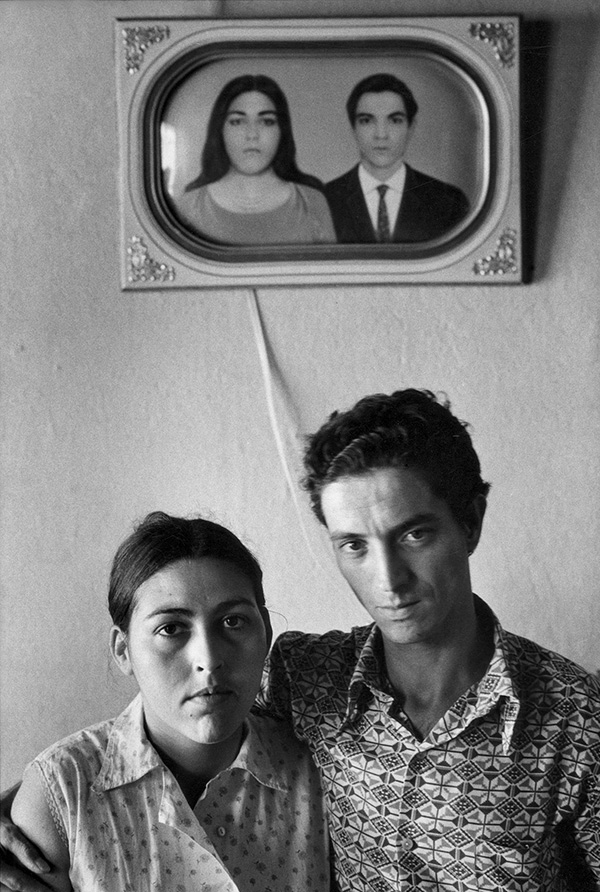
Gordon Parks, Untitled, Rio de Janeiro, Brazil, 1976
Courtesy The Gordon Parks Foundation
Butet-Roch: Henri Ballot’s photo-essay brings to mind the work that Gordon Parks subsequently did in Harlem in 1967, on the Fontenelle family, to illustrate American poverty. How did his time with Flávio and the O Cruzeiro riposte inform that series?
Roth: Certainly the Flávio story inspired that later story. However, while both Life and Parks later compared the two photo-essays, I wasn’t able to find any direct evidence in the Life corporate archives that his editors said: “Let’s redo the Flávio story in Harlem.” There are clear parallels, but also differences. There’s something darker, much more stark and harrowing, about Parks’s coverage of the Fontenelle family, with the exception of his iconic, melancholy image of the mother talking to a social welfare bureaucrat, surrounded by her children. By comparison, the Flávio story is a story of hope, and is quite romantic in its pictorial values and composition. I don’t know that Parks set out to romanticize or exoticize either of the families. He was working within the visual idioms of the times. While he certainly related to Flávio on some level, he must have seen himself even more in a couple of the Fontenelle boys. He grew up very poor in Fort Scott, Kansas, and then in St. Paul, Minnesota. Entering adulthood, he lived briefly in poverty in Harlem himself. He knew the Fontenelle story better, so perhaps that fostered more of an edge in his style. Or maybe, having passed through the experience with Flávio, he was more jaded as the 1960s were drawing to a close.
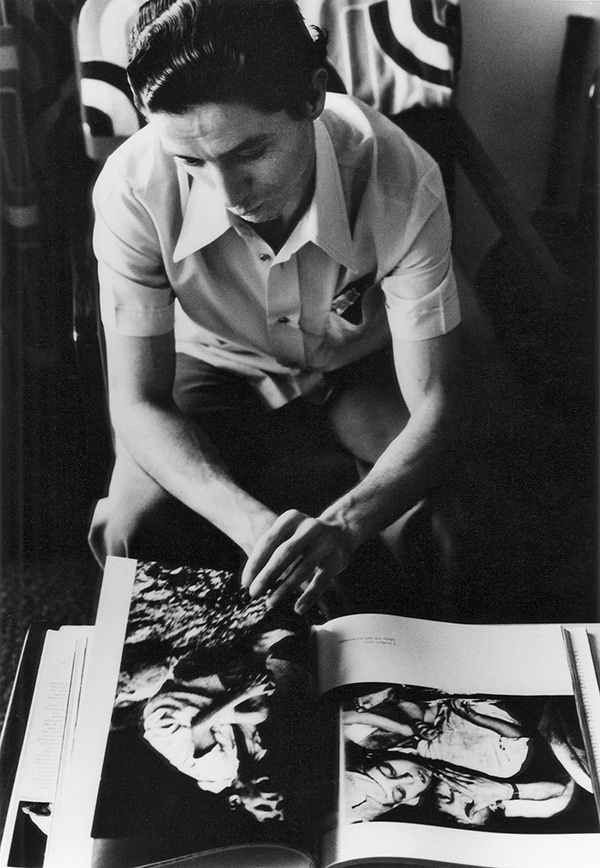
Gordon Parks, Untitled, Rio de Janeiro, Brazil, 1976
Courtesy The Gordon Parks Foundation
Butet-Roch: Why is it relevant to reflect upon such works and their impacts half a century later?
Roth: As a great photographer, filmmaker, writer, and composer—and also as a pioneering black American—Gordon Parks is somewhat like Jackie Robinson. Just as baseball historians exhaustively look at his career, you can exhaustively look at Parks, his work, and his place in history. There’s just so much there. He worked in so many different genres and with different media. At the end of it all, what he really boils down to is a great storyteller, one well worth examining and understanding.
In many ways, Flávio was his greatest story. It just couldn’t be contained. It was so compelling that the audience took it over and carried it forward. That makes it unusual. Yet at the same time it’s paradigmatic of his photojournalism.
It’s no surprise that Parks’s photographs had such a significant effect on Life’s audience. He wanted to move people, to shake them up, to take them into the lives of this distant family. He was intent on conveying the suffering of poverty. He succeeded beyond the wildest dreams of his editors. In a way there was nothing new about his approach. Characterizing poverty by representing the life of a single individual or family had been done before; taking readers from the developed world on an armchair journey to pockets of the developing world is a mainstay of documentary photography.
This idea, that photography has the power to change people’s lives for the better, is the mythology that gives us hope and makes so many of us look at similar pictures year after year. We believe that by looking at these images, we can change things, we can relieve the relative guilt we have over our affluence by looking at the lives of others. The Flávio story endures because the pictures affected Life’s readers so much that they decided to try to change fate. The fact that things didn’t work out as expected is what makes it so resonant and revealing, even today.
Gordon Parks: The Flávio Story travels to the J. Paul Getty Museum, Los Angeles, in July 2019.











